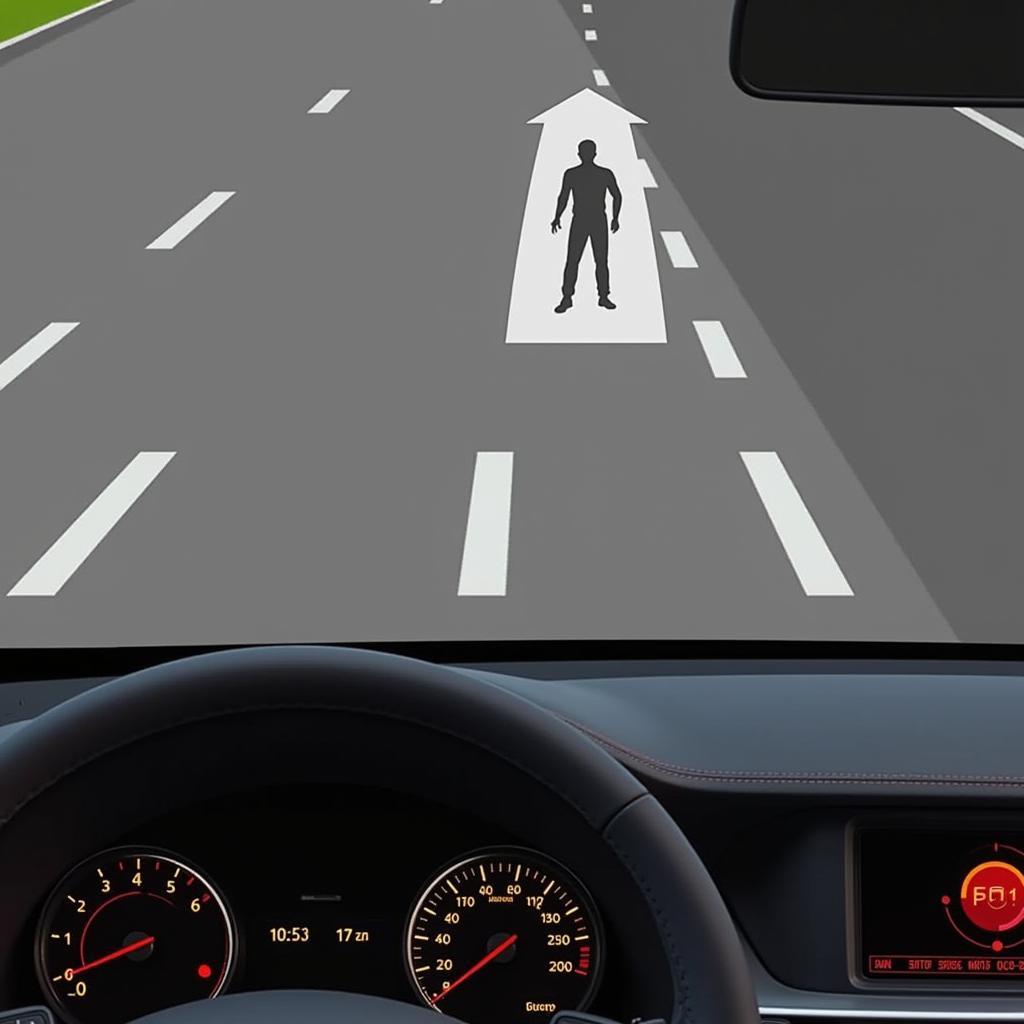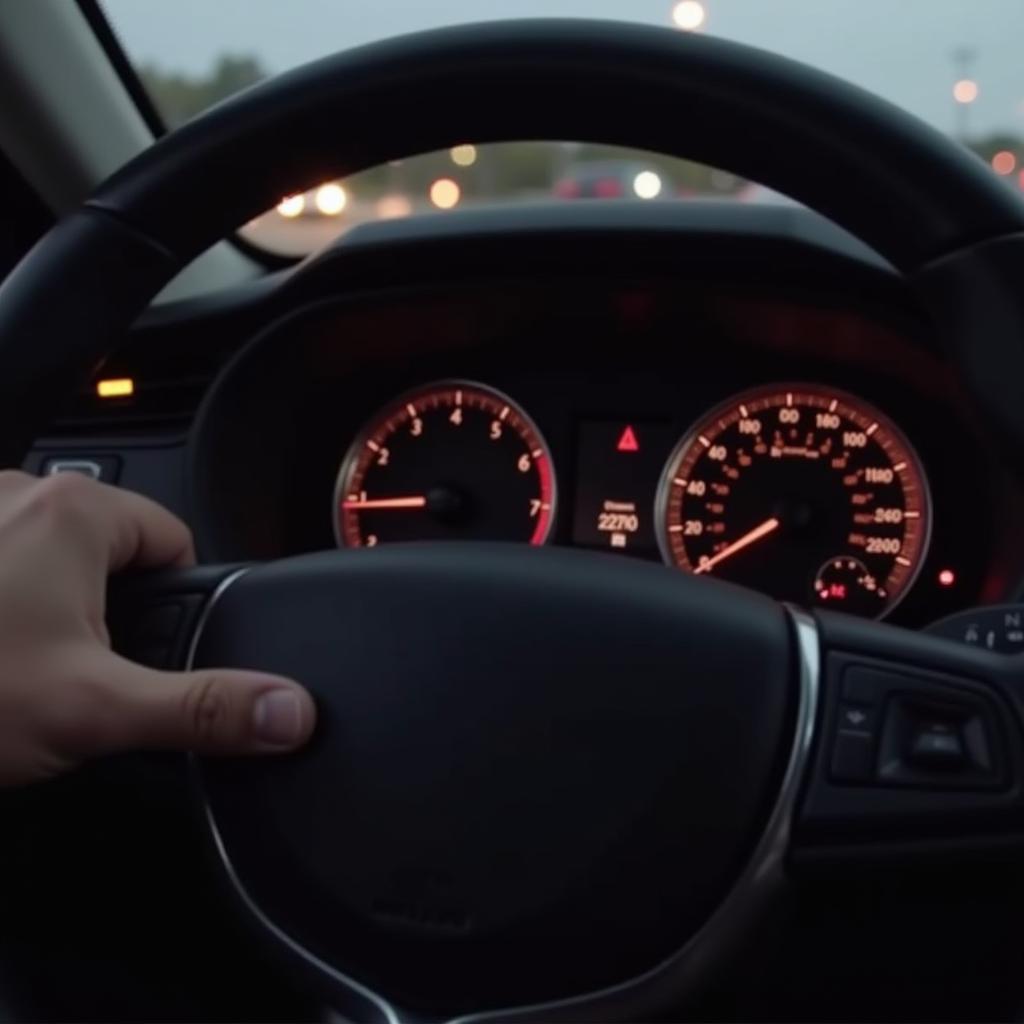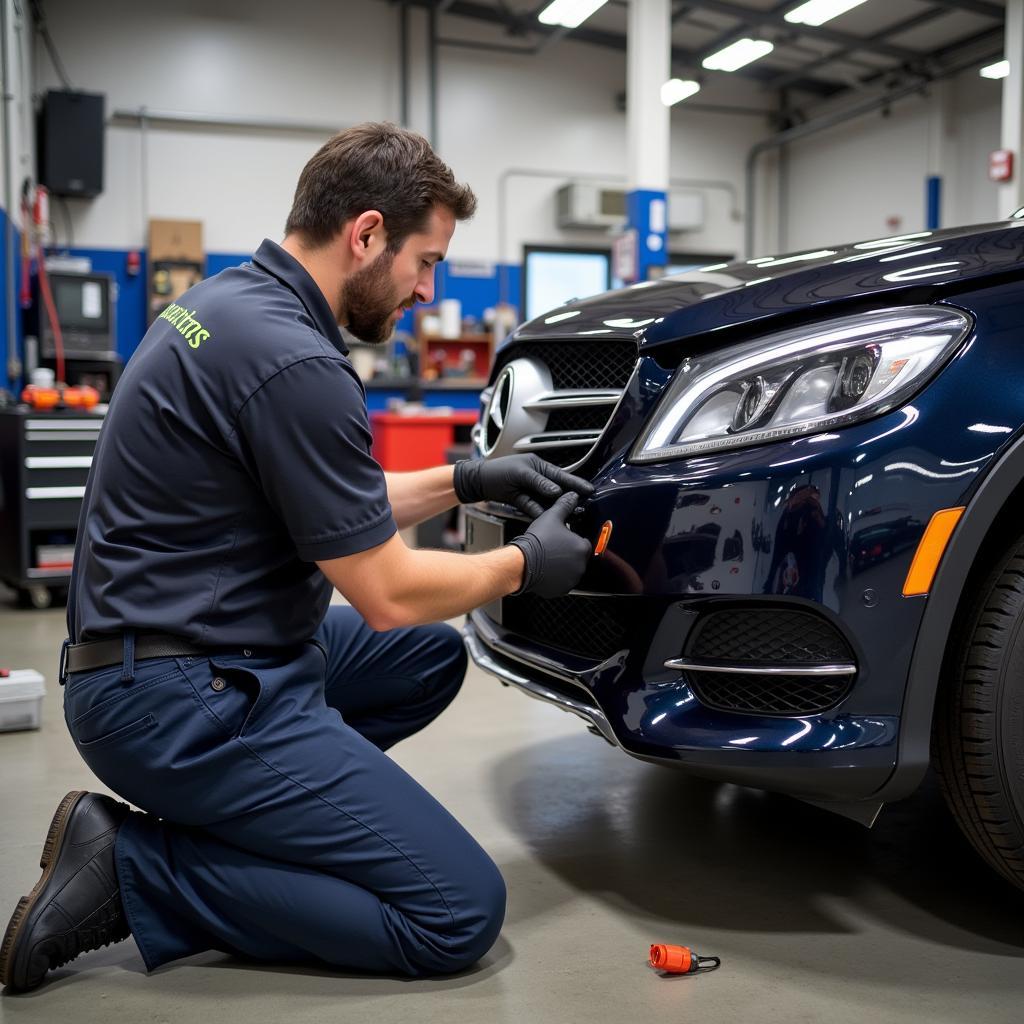Smart Brake Support (SBS) with Collision Warning is a cutting-edge driver-assist system designed to enhance safety and prevent collisions. This sophisticated technology utilizes sensors, radars, and cameras to monitor the road ahead, alerting the driver to potential hazards and automatically applying the brakes if necessary. While the technology might sound intimidating, understanding how SBS works can give you peace of mind and potentially save lives.
Imagine you’re driving down a busy street, and a pedestrian suddenly steps out from between parked cars. Your reaction time might not be fast enough to prevent an accident, but SBS can. The system’s sensors constantly scan the road, and if it detects an obstacle in your path, it will sound an alarm and flash a warning on your dashboard. If you fail to react in time, SBS can automatically engage the brakes, helping to mitigate the impact or even prevent the collision altogether.
 Smart Brake Support System in Action
Smart Brake Support System in Action
How Smart Brake Support Works
The core of the SBS system lies in its advanced sensor technology. These sensors, which can be radar, camera, or lidar based, work in unison to create a comprehensive view of the vehicle’s surroundings. The data from these sensors is constantly fed to the car’s central computer, which analyzes the information to identify potential hazards like other vehicles, pedestrians, cyclists, and even large animals.
Once a potential hazard is detected, the system calculates the risk of a collision based on factors like the vehicle’s speed, distance to the obstacle, and the obstacle’s trajectory. If the system determines that a collision is imminent, it will initiate a series of warnings and interventions to help the driver avoid the accident.
The first stage of intervention is typically a visual and audible warning. This could be a flashing icon on the dashboard, a warning message projected onto the head-up display, or a series of beeps. If the driver fails to react to these initial warnings, the system will escalate its response.
 Driver Receiving Collision Warning
Driver Receiving Collision Warning
The next stage of intervention usually involves a brief, automatic application of the brakes. This is known as “brake assist” and is designed to startle the driver into taking action while simultaneously preparing the braking system for a full stop if necessary. If the driver still doesn’t react and a collision is deemed unavoidable, the SBS system will automatically apply the brakes with full force to minimize the severity of the impact.
Benefits of Smart Brake Support with Collision Warning
The benefits of having a vehicle equipped with SBS with Collision Warning are numerous and significant:
- Reduced Risk of Collisions: This is the most obvious and arguably the most important benefit. By providing warnings and automatically applying the brakes, SBS can significantly reduce the likelihood of an accident.
- Mitigated Collision Severity: Even if a collision is unavoidable, SBS can help to lessen its severity by slowing the vehicle down before impact. This can mean the difference between a minor fender bender and a major accident.
- Increased Driver Awareness: The warnings provided by SBS can help make drivers more aware of their surroundings and potential hazards, encouraging safer driving habits.
- Enhanced Driver Confidence: Knowing that you have a safety net like SBS can give you more confidence behind the wheel, especially in challenging driving conditions.
Limitations of Smart Brake Support
While Smart Brake Support with Collision Warning is a highly effective safety system, it’s essential to understand its limitations:
- Environmental Factors: Adverse weather conditions like heavy rain, snow, or fog can impair the system’s sensors, reducing their effectiveness.
- System Malfunctions: Like any technology, SBS is not immune to malfunctions. It’s crucial to have the system regularly checked and maintained by a qualified technician.
- Driver Over-Reliance: While SBS enhances safety, it shouldn’t be a substitute for attentive driving. Over-reliance on the system can lead to complacency and increase the risk of accidents.
 Car Getting Serviced for SBS System
Car Getting Serviced for SBS System
Tips for Driving with Smart Brake Support
To get the most out of your vehicle’s Smart Brake Support system and ensure its optimal performance, keep these tips in mind:
- Familiarize Yourself with the System: Take the time to read your vehicle’s owner’s manual and understand how the SBS system works, including its warnings and limitations.
- Don’t Ignore Warnings: If the system issues a warning, don’t ignore it. React promptly and take appropriate action to avoid the hazard.
- Maintain a Safe Following Distance: Even with SBS, maintaining a safe following distance is crucial. This gives the system sufficient time to react and intervene if necessary.
- Regularly Service Your Vehicle: Have your vehicle serviced regularly by a qualified technician to ensure that the SBS system is functioning correctly.
Smart Brake Support with Collision Warning is a prime example of how technology is transforming the automotive industry, making vehicles safer and more intelligent. By understanding how this life-saving technology works, its benefits, limitations, and how to use it effectively, drivers can make informed decisions and contribute to a safer driving environment for everyone.
FAQs about Smart Brake Support
1. Can Smart Brake Support completely prevent all collisions?
While SBS significantly reduces the risk of collisions, it’s not a guarantee of accident prevention. Factors like environmental conditions, driver behavior, and system limitations can still lead to accidents.
2. Does Smart Brake Support work at all speeds?
Most SBS systems have a minimum speed threshold below which they are not active. The exact speed range varies depending on the vehicle make and model, so refer to your owner’s manual for specific information.
3. Will Smart Brake Support engage if I’m reversing?
Some SBS systems are also equipped with rear-facing sensors and can engage when reversing. However, this is not standard across all vehicles, so it’s important to check your vehicle’s specifications.
4. Can I turn off Smart Brake Support?
Most vehicles allow you to adjust the sensitivity of the SBS system or temporarily disable it. However, it’s generally not recommended to completely turn off this important safety feature.
5. What should I do if my Smart Brake Support system malfunctions?
If you experience any issues with your SBS system, such as false warnings or failure to activate, take your vehicle to a qualified technician for inspection and repair as soon as possible.
This article provides a comprehensive overview of Smart Brake Support (SBS) with Collision Warning, a significant advancement in automotive safety technology. By understanding this system’s functionality, benefits, and limitations, drivers can make informed decisions and utilize this technology to enhance their safety on the road.
Remember, if you’re experiencing issues with your vehicle’s warning systems, such as those indicating the need for an oil change or an inspection, it’s crucial to address them promptly. For more information on specific vehicle warning messages, you can find helpful resources online. For instance, articles on “seat ibiza oil change warning message”, “seat ibiza insp warning”, and “seat ibiza orange warning light” can provide valuable insights and guidance for SEAT Ibiza owners.
